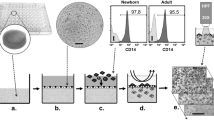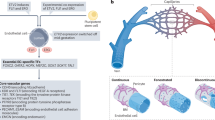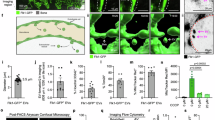Abstract
Introduction:
We have identified a novel hierarchy of human endothelial colony–forming cells (ECFCs) that are functionally defined by their proliferative and clonogenic potential and in vivo vessel-forming ability. The rhesus monkey provides an excellent model in which to examine the changes in circulating concentrations and functions of ECFCs since this nonhuman primate possesses a long lifespan and has been used extensively to model age-related processes that occur in humans.
Results:
Endothelial cells (ECs) derived from rhesus monkey ECFCs share a cell-surface phenotype similar to human cord blood ECFCs, rapidly form capillary-like structures in vitro, and form endothelial-lined vessels in vivo upon implantation in immunodeficient mice in an age-dependent manner. Of interest, although ECFCs from the oldest monkeys formed capillary-like structures in vitro, the cells failed to form inosculating vessels when implanted in vivo and displayed a deficiency in cytoplasmic vacuolation in vitro; a critical first step in vasculogenesis.
Discussion:
Utilizing previously established clonogenic assays for defining different subpopulations of human ECFCs, we have shown that a hierarchy of ECFCs, identical to human cells, can be isolated from the peripheral blood of rhesus monkeys, and that the frequency of the circulating cells varies with age. These studies establish the rhesus monkey as an important preclinical model for evaluating the role and function of circulating ECFCs in vascular homeostasis and aging.
Methods:
Peripheral blood samples were collected from 40 healthy rhesus monkeys from birth to 24 years of age for ECFC analysis including immunophenotyping, clonogenic assays, and in vivo vessel formation.
Similar content being viewed by others
Log in or create a free account to read this content
Gain free access to this article, as well as selected content from this journal and more on nature.com
or
References
Hirschi KK, Ingram DA, Yoder MC . Assessing identity, phenotype, and fate of endothelial progenitor cells. Arterioscler Thromb Vasc Biol 2008;28:1584–95.
Asahara T, Murohara T, Sullivan A, et al. Isolation of putative progenitor endothelial cells for angiogenesis. Science 1997;275:964–7.
Povsic TJ, Zavodni KL, Vainorius E, Kherani JF, Goldschmidt-Clermont PJ, Peterson ED . Common endothelial progenitor cell assays identify discrete endothelial progenitor cell populations. Am Heart J 2009;157:335–44.
Timmermans F, Plum J, Yoder MC, Ingram DA, Vandekerckhove B, Case J . Endothelial progenitor cells: identity defined? J Cell Mol Med 2009;13:87–102.
Kawamoto A, Losordo DW . Endothelial progenitor cells for cardiovascular regeneration. Trends Cardiovasc Med 2008;18:33–7.
Michowitz Y, Goldstein E, Wexler D, Sheps D, Keren G, George J . Circulating endothelial progenitor cells and clinical outcome in patients with congestive heart failure. Heart 2007;93:1046–50.
Fadini GP, Sartore S, Albiero M, et al. Number and function of endothelial progenitor cells as a marker of severity for diabetic vasculopathy. Arterioscler Thromb Vasc Biol 2006;26:2140–6.
Ingram DA, Mead LE, Tanaka H, et al. Identification of a novel hierarchy of endothelial progenitor cells using human peripheral and umbilical cord blood. Blood 2004;104:2752–60.
Ingram DA, Caplice NM, Yoder MC . Unresolved questions, changing definitions, and novel paradigms for defining endothelial progenitor cells. Blood 2005;106:1525–31.
Yoder MC, Mead LE, Prater D, et al. Redefining endothelial progenitor cells via clonal analysis and hematopoietic stem/progenitor cell principals. Blood 2007;109:1801–9.
Au P, Daheron LM, Duda DG, et al. Differential in vivo potential of endothelial progenitor cells from human umbilical cord blood and adult peripheral blood to form functional long-lasting vessels. Blood 2008;111:1302–5.
Melero-Martin JM, De Obaldia ME, Kang SY, et al. Engineering robust and functional vascular networks in vivo with human adult and cord blood-derived progenitor cells. Circ Res 2008;103:194–202.
Hu J, Takatoku M, Sellers SE, et al. Analysis of origin and optimization of expansion and transduction of circulating peripheral blood endothelial progenitor cells in the rhesus macaque model. Hum Gene Ther 2002;13:2041–50.
Somani A, Nguyen J, Milbauer LC, Solovey A, Sajja S, Hebbel RP . The establishment of murine blood outgrowth endothelial cells and observations relevant to gene therapy. Transl Res 2007;150:30–9.
Huang L, Hou D, Thompson MA, et al. Acute myocardial infarction in swine rapidly and selectively releases highly proliferative endothelial colony forming cells (ECFCs) into circulation. Cell Transplant 2007;16:887–97.
Alvarez DF, Huang L, King JA, ElZarrad MK, Yoder MC, Stevens T . Lung microvascular endothelium is enriched with progenitor cells that exhibit vasculogenic capacity. Am J Physiol Lung Cell Mol Physiol 2008;294:L419–30.
Huang L, Harkenrider M, Thompson M, et al. A hierarchy of endothelial colony-forming cell activity displayed by bovine corneal endothelial cells. Invest Ophthalmol Vis Sci 2010;51:3943–9.
Schniedermann J, Rennecke M, Buttler K, et al. Mouse lung contains endothelial progenitors with high capacity to form blood and lymphatic vessels. BMC Cell Biol 2010;11:50.
Melero-Martin JM, Khan ZA, Picard A, Wu X, Paruchuri S, Bischoff J . In vivo vasculogenic potential of human blood-derived endothelial progenitor cells. Blood 2007;109:4761–8.
Traktuev DO, Prater DN, Merfeld-Clauss S, et al. Robust functional vascular network formation in vivo by cooperation of adipose progenitor and endothelial cells. Circ Res 2009;104:1410–20.
Kamei M, Saunders WB, Bayless KJ, Dye L, Davis GE, Weinstein BM . Endothelial tubes assemble from intracellular vacuoles in vivo. Nature 2006;442:453–6.
Sacharidou A, Koh W, Stratman AN, Mayo AM, Fisher KE, Davis GE . Endothelial lumen signaling complexes control 3D matrix-specific tubulogenesis through interdependent Cdc42- and MT1-MMP-mediated events. Blood 2010;115:5259–69.
Lee CC, Fletcher MD, Tarantal AF . Effect of age on the frequency, cell cycle, and lineage maturation of rhesus monkey (Macaca mulatta) CD34+ and hematopoietic progenitor cells. Pediatr Res 2005;58:315–22.
Author information
Authors and Affiliations
Corresponding author
Rights and permissions
About this article
Cite this article
Shelley, W., Leapley, A., Huang, L. et al. Changes in the frequency and in vivo vessel-forming ability of rhesus monkey circulating endothelial colony–forming cells across the lifespan (birth to aged). Pediatr Res 71, 156–161 (2012). https://doi.org/10.1038/pr.2011.22
Received:
Accepted:
Published:
Issue date:
DOI: https://doi.org/10.1038/pr.2011.22
This article is cited by
-
Evaluation of ex vivo produced endothelial progenitor cells for autologous transplantation in primates
Stem Cell Research & Therapy (2018)
-
miR-193a-3p interaction with HMGB1 downregulates human endothelial cell proliferation and migration
Scientific Reports (2017)
-
Human proangiogenic circulating hematopoietic stem and progenitor cells promote tumor growth in an orthotopic melanoma xenograft model
Angiogenesis (2013)



